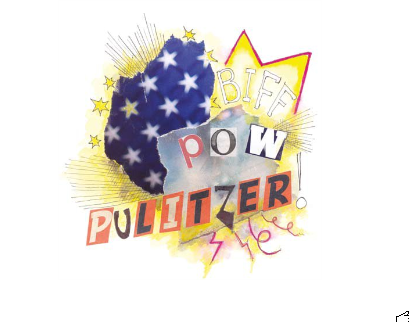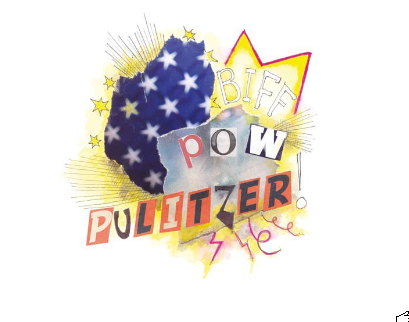 Later this year the film version of one of the best known comic books of our time will be hitting the big screen. Until that time, the gaze has turned to the comic book world in anticipation of this year’s celluloid smash.
Later this year the film version of one of the best known comic books of our time will be hitting the big screen. Until that time, the gaze has turned to the comic book world in anticipation of this year’s celluloid smash.
Not only is Watchmen probably the most respected within the comic book genre but it is also recognised outwith its peers. Featuring in Time Magazine’s top 100 novels of the 20th century, the Alan Moore/David Gibbons masterpiece is the only graphic novel among the ‘real’ books. But is the comic book genre being overlooked by literary critics? Who should we be watching, other than The Watchmen? Laura Doherty enlisted Montreal resident (North America’s hub of alternative comics) and lecturer in comics, Nicolas Carrier, to help us find out.
First of all Nicolas wants to clarify his stance on the term ‘graphic novel’ as commonly bandied about the world of comics: “I’m kind of ambivalent about the term. I think it’s important to acknowledge that comics as a medium is now used to tell long, complex narratives akin to those found in novels, but calling them ‘graphic novels’ sounds a bit condescending. It valorises some comics, in a patronising way, all the while implying that the rest of the medium is shit. It’s also an oversimplification: a long-format comic is not just a novel told through graphics; it functions in a very different way, in terms of structure and how it’s read. Will Eisner coined the term ‘graphic novel’ in order to woo a publisher in a time when no publisher of literature would have taken a mere comic seriously. I think we’re well past that now, so let’s get to using the word ‘comics’ with a straight face and elevate the medium as a whole in the public eye.”
A common delusion with comics, one propagated even by Watchmen, is that they are about following the exploits of superheroes and crime fighters, but as Moore’s work has proven there is a massive amount of psychological depth to be found within these spheres and even more worth meriting outside of the superhero realm.
The comic form has become a recurrently popular mode for representing the real world: Joe Sacco for instance – a war correspondent who utilises the comic form in his reports. His depictions of war, such as found within Palestine, offer a powerful insight into the frontline experience – the combination of pictures and prose connect the reality of living in conflict in a direct, first-person manner. Nicolas acknowledges this phenomenon: “Beyond Sacco there are also a lot of fiction comics interested in journalism set in a near-future context, for example; Transmetropolitan by Warren Ellis, DMZ by Brian Wood, Shooting War by Anthony Lappé and The Nightly News by Jonathan Hickman. Having a journalist for a protagonist also makes it easier to introduce a new setting or context.” Of course, framing an avid reporter in the comic book’s action is a tried and tested concept – even those unfamiliar with the world of comics will be aware of Peter Parker and Clark Kent’s respective roles in the newspaper world.
Nicolas ponders the connection between journalism and comics: “The first American comics were newspaper comic strips, and some of the most famous superheroes ever have been reporters to pay the bills. Comic creators way back in the early days must’ve been very aware of journalism, as their product was always surrounded by it: maybe the effect of that still lingers, albeit in a severely displaced sort of way. ”
As well as comic book writers making their protagonists dabble in shorthand and deadlines for fiction-based fodder, they have used the stark realism of their own life story as the driving force for comics. Art Spiegelman is probably the most obvious example, with his Pulitzer award winning Maus. This comic – depicting the Holocaust as told through animal figures – was revolutionary for the comic book format. Nicolas explains the effect of autobiography within comics: “For writers like R Crumb, Harvey Pekar and Spiegelman autobiography was the best way they could see to rebel against established mainstream comic conventions, which were then obsessed exclusively with power fantasies. They also earned a bit of clout for the medium in this process as autobiography is a perfectly respectable literary genre.” Other writers have since followed suit, presenting witty, stark, true-life accounts of adolescent experience, such as Fun Home by Alison Bechdel and Chester Brown’s I Never Liked You. These intelligent works build a very nuanced picture of youth by utilising pop culture and literary references into the work to direct them to new purpose.
The comic form, being the correlation of word and image as it is, seems unafraid to look to other cultural pulse-points outwith itself with which to engage, often providing a refreshing focus in parallel with its own creativity. Hopefully, in time, comic book work will be recognised by the culture it opens its arms to and held in the same regard as the canonical literature and art with which it so readily engages.
It may only be a matter of time the wake of Watchmen before the intellectual, the real-life stories and the important narratives lying dormant beneath the suited, comic exterior will explode to the surface in a flurry of brightly coloured lycra and metallic breastplates: BIFF! POW! PULITZER!

